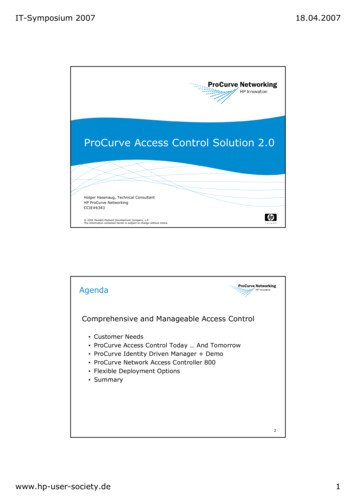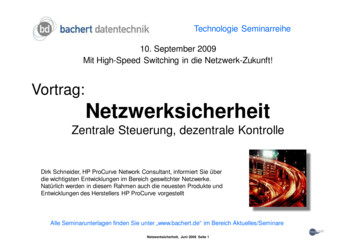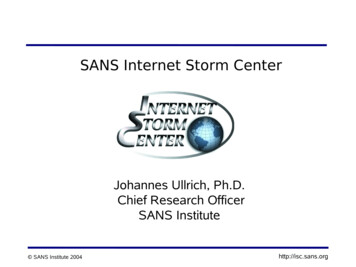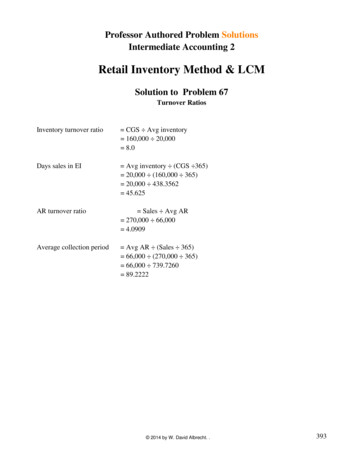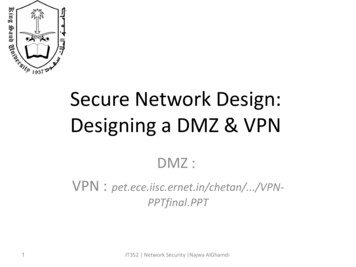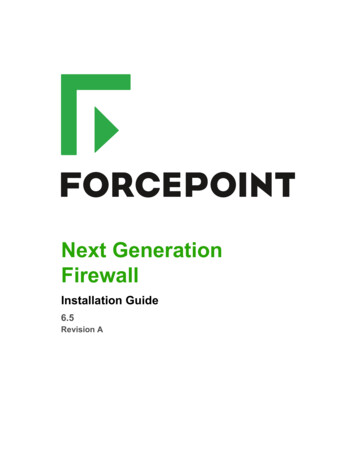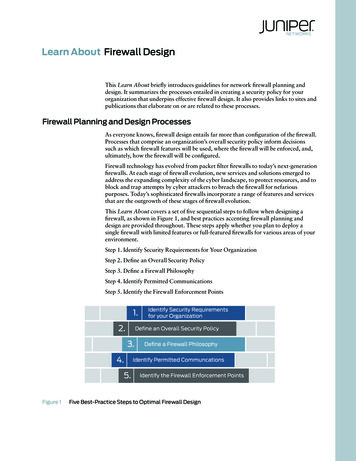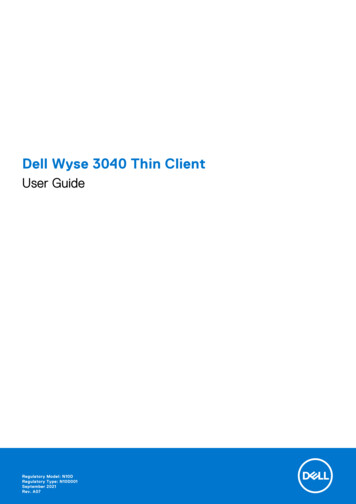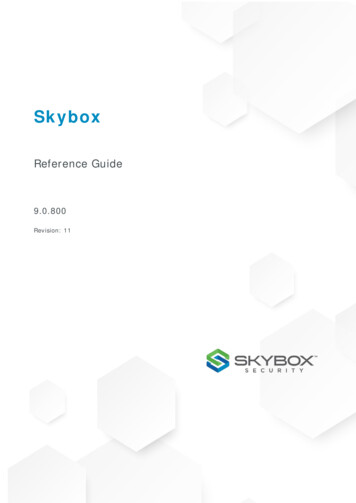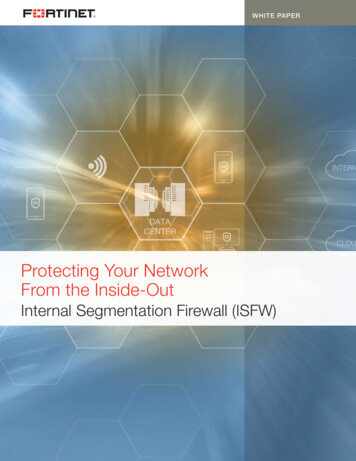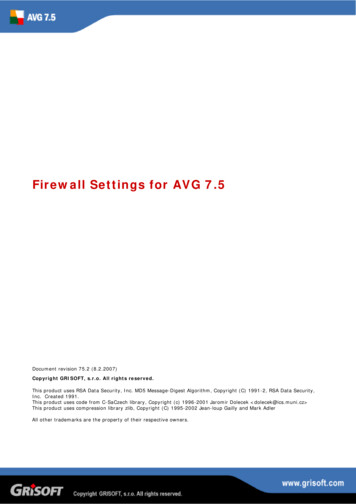
Transcription
Firewall Settings for AVG 7.5Document revision 75.2 (8.2.2007)Copyright GRISOFT, s.r.o. All rights reserved.ThisInc.ThisThisproduct uses RSA Data Security, Inc. MD5 Message-Digest Algorithm, Copyright (C) 1991-2, RSA Data Security,Created 1991.product uses code from C-SaCzech library, Copyright (c) 1996-2001 Jaromir Dolecek dolecek@ics.muni.cz product uses compression library zlib, Copyright (C) 1995-2002 Jean-loup Gailly and Mark AdlerAll other trademarks are the property of their respective owners.
Contents1. Introduction. 32. Windows XP built-in firewall (Security Center). 43. Kerio Personal Firewall . 83.1. Run Kerio Personal Firewall. 83.2. Network Security . 83.3. System Security.104. Zone Alarm Pro . 135. Microsoft ISA Server . 166. Agnitum Outpost Firewall . 236.1. Allowing Activities for an Application .236.2. Configuring the Firewall at Once .237. Sygate Personal Firewall. 267.1. Allowing Activities for an Application .267.2. Configuring the Firewall at Once .268. Kerio Winroute Firewall . 309. Technical Support . 31
31. IntroductionIn case you have installed AVG on your computer, and you are running a firewall atthe same time, you might be experiencing problems while sending/receiving emailmessages and/or downloading AVG updates.This documentation refers to the firewall settings required for proper AVGfunctionality and it covers the settings instructions and recommendations for thefollowing firewalls:zWindows XP built-in firewall (Security Center)zKerio Personal FirewallzZone Alarm Pro firewallzMicrosoft ISA ServerzAgnitum Outpost FirewallzSygate Personal FirewallzKerio Winroute Firewall
42. Windows XP built-in firewall (Security Center)Typically, the Windows XP built-in firewall default settings correspond very wellto AVG configuration. Most probably, no problems will occur at all. However, shouldyou run up against problems, please follow these steps:zWindows XP Firewall SettingsOpen the Windows Firewall settings dialog window: Start / Settings /Control Panels / Windows Firewall. On the General tab make sure the Donot allow exceptions option is not selected.zDefine ExceptionsSwitch to the Exceptions tab with the list of applications that are blocked toaccess to the internet. You need to allow access to internet for all AVGapplications. To do so, mark each check box related to an AVG application inthe list of programs and services (see the following screenshot).
5The AVG applications to be selected from the list and marked as allowed areas follows:oAVG for WindowsoAVG Control Centeroavgemc.exe (only when the AVG EMS application is installed)oavginet.exeIf these applications are not listed in the list of exceptions, you need to addthem manually. This can be done using the Add Program button (see theabove screenshot).zAdd a New ProgramA new dialog window opens providing a list of programs that can be added tothe previously seen Windows Firewall list of exceptions. Select the AVGapplications from the list, and confirm adding them to the Windows Firewalllist of exceptions by pressing the OK button (see the following screenshot).
6In case you are not able to see any AVG application in the program list, youhave to add them manually. Click the Browse button, and find the abovelisted files (avgw.exe, avgcc.exe, avginet.exe and avgemc.exe) in the AVG7program folder (by default C:\Program Files\Grisoft\AVG7):Confirm adding the selected files by pressing the OK button in the Add aProgram dialog window.zAVG Remote AdministrationIn case the station you are working with is a part of the AVG RemoteAdministration, and it is:orunning as an AVG client connected to the AVG DataCenter;orunning AVGADMIN and AVG TCP Server at the same time;orunning AVGADMIN;
7it is necessary to specify ports to be opened through the Windows XP builtin firewall. To specify the ports numbers use the Add a port dialog that canbe opened via the Add a port button in the Exceptions tab:You need to add one by one the following ports:o4156o6051o6052o6053o6150
83. Kerio Personal FirewallWith the Kerio Personal Firewall you will probably need to configure the settingsto allow AVG (and its applications) to connect to the internet (send/receive data),and to launch other applications (to update). To configure the Kerio PersonalFirewall settings, follow these steps:3.1. Run Kerio Personal FirewallYou should see the Kerio Personal Firewall shield icon in your system tray –double-click on it to open the Kerio Personal Firewall configuration window.If you cannot see such an icon, you have to launch the Firewall Engine from theAll Programs / Kerio / Personal Firewall X folder of the Windows Start menu.The X stands for the version of your product (for example 4). The Kerio PersonalFirewall icon in the system tray will be present then.3.2. Network SecurityIn the Network Security item (left menu), Applications tab (top menu) you areable to overview a list of programs with the information on whether these areallowed to connect to the internet. In the list, verify that all AVG applications arelabeled as permit in all fields present (Trusted In/Out and internet In/Out).Here is the list of all AVG applications that must always be allowed to connect to theinternet:oavginet.exe – application for performing AVG online updates (located inthe Program Files/Grisoft/Avg7 directory by default)oavgemc.exe – AVG E-mail Scanner for anti-virus scanning of e-mail(located in the Program Files/Grisoft/Avg7 directory by default)Following two applications must be allowed to access the network when theworkstation is a part of AVG Remote Administration:oavgmsvr.exe – AVG Alert Manager component (located in theProgram Files/Grisoft/Avg7 directory by default)oavgcc.exe – AVG Control Center (located in the ProgramFiles/Grisoft/Avg7 directory by default)And finally, when there are installed the control components of AVG RemoteAdministration on the workstation, the following applications must be also allowedto communicate over the network:oavgadmin.exe – the main control application of AVG RemoteAdministration, AVGADMIN (if the product is installed on yourcomputer, it is located in the Program Files/Grisoft/AvgAdmin7 bydefault)oavgtcpsv.exe – AVG TCP Server application for AVG RemoteAdministration (if the product is installed on your computer, it islocated in the Program Files/Grisoft/AVG TCP Server by default)oavginetl.exe – AVG InetLite application (if installed, it is located in theProgram Files/Grisoft/Avg TCP Server by default)
9If any AVG application you need to be allowed to access the network is notpermitted, you have to change its status. To do so, right click on every item andselect the Permit option from the context menu:Press the Apply button in the Kerio Personal Firewall / Network Securitywindow after finishing the network security configuration to confirm the changesperformed (you will be asked for it otherwise).If some application is missing on the list, it will be added when you attempt tolaunch it and/or when the application will try to connect to the network. KerioPersonal Firewall warning related to the particular AVG application will bedisplayed then:
10Press the Permit button there and refresh the list in the Kerio Personal Firewall/ Network Security configuration window then (by pressing the Refresh buttonin the right-down corner). After doing this, you can label the application aspermitted in all fields present as described in the beginning of this section.3.3. System SecurityIn the System Security item (left menu), Applications tab (top menu) you areable to overview a list of programs with the information on whether these areallowed to launch other application. Again, you need to make sure all AVGapplications listed are labeled as permit to launch other applications (e.g. updates).If not, you need to change the AVG applications’ status. To do so, right click onevery field present (Starting, Modifying and Launching others) and select thePermit option from the context menu.
11Press the Apply button in the Kerio Personal Firewall / System Securitywindow after finishing the network security configuration to confirm the changesperformed (you will be asked for it otherwise).If some application is missing on the list, it will be added for example when itattempts to launch another application. Kerio Personal Firewall warning relatedto the particular AVG application will be displayed then:
12Press the Permit button there and refresh the list in the Kerio Personal Firewall/ System Security configuration window then (by pressing the Refresh buttonin the right-down corner). Then you can label the application as permitted in allfields present as described in the beginning of this section.
134. Zone Alarm ProWith the Zone Alarm Pro you will probably need to configure the settings so that itis allowed for the AVG (and its applications) to connect to the internet(send/receive data), and to launch other applications (to update). To configure theZone Alarm Pro settings, follow these steps:zRun Zone Alarm ProYou should see the ZoneAlarm Pro icon in your system tray – double-click onit to open the ZoneAlarm Pro configuration window.If you cannot see such an icon, you have to launch the Zone Labs Securityapplication from the All Programs / Zone Labs folder of the Windows Startmenu. The ZoneAlarm Pro icon in the system tray will be present then.zProgram ControlIn the Program Control section (left menu), Programs tab (top menu) youare able to overview a list of programs with the information on whether theseare allowed to connect to the internet. In the list, verify that all AVGapplications are labeled as allowed (green confirmation mark).If not, you have to change the AVG applications’ status. To do so, right clickon every item and select the confirmation mark from the context menu.Here is the list of all AVG applications that must always be allowed to connectto the internet:oavginet.exe – application for performing AVG online updates (located inthe Program Files/Grisoft/Avg7 directory by default)oavgemc.exe – AVG E-mail Scanner for anti-virus scanning of e-mail(located in the Program Files/Grisoft/Avg7 directory by default)
14Following two applications must be allowed to access the network when theworkstation is a part of AVG Remote Administration:oavgmsvr.exe – AVG Alert Manager component (located in theProgram Files/Grisoft/Avg7 directory by default)oavgcc.exe – AVG Control Center (located in the ProgramFiles/Grisoft/Avg7 directory by default)And finally, when there are installed the control components of AVG RemoteAdministration on the workstation, the following applications must be also allowedto communicate over the network:zoavgadmin.exe – the main control application of AVG RemoteAdministration, AVGADMIN (if the product is installed on yourcomputer, it is located in the Program Files/Grisoft/AvgAdmin7 bydefault)oavgtcpsv.exe – AVG TCP Server application for AVG RemoteAdministration (if the product is installed on your computer, it islocated in the Program Files/Grisoft/Avg TCP Server by default)oavginetl.exe – AVG InetLite application (if installed, it is located in theProgram Files/Grisoft/Avg TCP Server by default)Add a ProgramIf any of the needed applications described in the list above is missing in thePrograms tab of the ZoneAlarm Pro / Program Control window, you haveto add it manually. Press the Add button in the right-down corner of thewindow:
15Choose the desired application in the following dialog:By default, the files are located in the Grisoft program folder (ProgramFiles/Grisoft/AVG7, Program Files/Grisoft/AvgAdmin7 or ProgramFiles/Grisoft/Avg TCP Server), as described in the list in previous section.zE-mail ProtectionIn the E-mail Protection item (left menu), Main tab (top menu) you need todisable the built-in inbound/outbound email protection provided by the ZoneAlarm Pro. By switching the Zone Alarm Pro implemented email verificationoff you will enable the more comprehensive AVG email control.
165. Microsoft ISA ServerAny network traffic is blocked by default after installation of ISA Server. If youwant to allow AVG applications to connect to the network, you must create at leastone rule in the ISA Server environment.To create a rule, follow the steps below:zOpen the Microsoft ISA Server Main Configuration WindowzLaunch the New Access Rule WizardChoose the Microsoft Internet Security and Acceleration Server 2004item in the main navigation tree located in the left side of the window. Thename of your computer should be displayed here. Unpack it (for example bydouble-clicking on the computer’s icon in the navigation tree) and choose theFirewall Policy item:Go to the Tasks tab in the right side of the window then and choose theCreate New Access Rule action. The wizard’s window displays then.zProceed with the New Access Rule WizardFill in the name of the new rule (e. g. AVG):
17Choose the Allow option in the next window (the rule’s purpose is to allow theAVG applications to communicate over the network):In the following Protocols window choose the Selected protocols option inthe This rule applies to field:
18Use the Add button to open the tree menu with protocols available to add:Choose the HTTP and HTTPS protocols in the Add Protocols window usingthe Add button.
19When the station is a part of AVG Remote Administration, or when thereare the AVGADMIN and/or the AVG TCP Server applications running on thestation, you have to add also the TCP protocol as well.However, any station may be in need of use of the TCP protocol under somecircumstances (for example when performing an update from a local webserver), so it is always recommended to add the TCP protocol connection!The protocol is not in the list, so you must create a new protocol connectionusing the New button in the upper area of the Add Protocols window.A New Protocol Definition Wizard launches then. Choose a name for thenew protocol connection (e.g. AVGADMIN). Press the New button then. ANew/Edit Protocol Connection window appears:Choose the following values for the fields present:oTCP Protocol typeoOutbound DirectionoPort Range from 4156 to 4156Press the OK button to confirm the changes.Do the same procedure of creating a new protocol connection once more then.All values remain the same except for the Port Range, which will be from6051 to 6053 now.The New Protocol Definition Wizard window with the protocol listing willnow look like this:
20Press the Next button to continue.In the next window with secondary connections prompt choose No andcontinue pressing the Next button. Complete the New Protocol DefinitionWizard by clicking on the Finish button.Now you can add the newly created protocol connection in the Add Protocolswindow:
21Your protocol is in the User-Defined folder of the tree menu here. Use theAdd button to add it.The Protocols window of the New Access Rule Wizard should look like thisnow:
22Press the Next button to continue.Choose the sources and destinations of data on selected ports in the next twowindows. Use the Add button and select the External, Localhost andInternal (in case your ISA Server acts as gate for internet connection ofother computers in your network) in the tree menu again.Both of the sources and destinations windows should look like this then:Press the Next button to continue and complete the wizard by clicking on theFinish button.Save the changes in the Firewall policy by clicking on the Apply button thatis located above the rule list.Microsoft ISA Server should be configured properly in order to allow all AVGapplications to communicate over the network now.
236. Agnitum Outpost FirewallYou may be asked to allow network connection for some applications during theirstart up after installation of the product. This is related to AVG products as well.You can set up the firewall so that it will permanently allow network communicationfor all AVG applications. Doing this you will definitely not decrease the level ofprotection of your system. On the contrary, AVG will be enabled to fully employ allof its functions then, bringing the reliability of your anti-virus protection tomaximum.6.1. Allowing Activities for an ApplicationThe firewall will react whenever an unknown application is trying to make a networkconnection. This holds even for AVG applications before setting them up manually.The following window is displayed (for AVG Control Center in this example):Choose the Allow all activities for this application option and press the OKbutton. Perform the same action whenever a similar AVG related window appears.6.2. Configuring the Firewall at OnceHowever, you should allow the AVG applications to access the network even beforethey try to open a connection. If you want to allow the network communication forAVG applications (recommended!) at once, open the Agnitum Outpost Firewallmain window:
24Add the allowed applications by right-clicking on the Plugins item in the mainnavigation tree. Choose the Options menu item then. A new window will open then.Go to the Applications tab in the window:Add all AVG applications currently installed on your computer using the Add button.Here is the list of all AVG applications that must always be allowed to connect to theinternet:
25oavginet.exe – application for performing AVG online updates (located inthe Program Files/Grisoft/Avg7 directory by default)oavgemc.exe – E-mail Scanner for anti-virus scanning of e-mail(located in the Program Files/Grisoft/Avg7 directory by default)Following two applications must be allowed to access the network when theworkstation is a part of AVG Remote Administration:oavgmsvr.exe – AVG Alert Manager component (located in theProgram Files/Grisoft/Avg7 directory by default)oavgcc.exe – AVG Control Center (located in the ProgramFiles/Grisoft/Avg7 directory by default)And finally, when there are installed the control components of AVG RemoteAdministration on the workstation, the following applications must be also allowedto communicate over the network:oavgadmin.exe – the main control application of AVG RemoteAdministration, AVGADMIN (if the product is installed on yourcomputer, it is located in the Program Files/Grisoft/AvgAdmin7 bydefault)oavgtcpsv.exe – AVG TCP Server application for AVG RemoteAdministration (if the product is installed on your computer, it islocated in the Program Files/Grisoft/Avg TCP Server by default)oavginetl.exe – AVG InetLite application (if installed, it is located in theProgram Files/Grisoft/Avg TCP Server by default)Commit your selection by pressing the OK button. All AVG applications requiringthe network communication should be fully operational then.
267. Sygate Personal FirewallYou may be asked to allow network connection for some applications during theirstart up also after installation of the Sygate Personal Firewall product. This isrelated to AVG products as well.You can set up the firewall so that it will permanently allow network communicationfor all AVG applications. Doing this you will definitely not decrease the level ofprotection of your system. On the contrary, AVG will be enabled to fully employ allof its functions then.7.1. Allowing Activities for an ApplicationThe firewall will react whenever an unknown application is trying to make a networkconnection. This holds even for AVG applications. The following window is displayed(for AVG Control Center in this example):Check the Remember my answer field and press the Yes button. Repeat theaction for any AVG application that tries to connect the network.7.2. Configuring the Firewall at OnceIf you want to allow the network communication for AVG applications at once(recommended!), open the Sygate Personal Firewall main window:
27Select the Advanced Rules menu item in the Tools folder of the main applicationmenu. A new window will open then:You can create a new rule for the AVG applications using the Add button in theAdvanced Rules Settings window. Go to the Applications tab first:
28Add all AVG applications currently installed on your system using the Browsebutton.Here is the list of all AVG applications that must always be allowed to connect tothe internet:oavginet.exe – application for performing AVG online updates (located inthe Program Files/Grisoft/Avg7 directory by default)oavgemc.exe – AVG E-mail Scanner for anti-virus scanning of e-mail(located in the Program Files/Grisoft/Avg7 directory by default)Following two applications must be allowed to access the network when theworkstation is a part of AVG Remote Administration:oavgmsvr.exe – AVG Alert Manager component (located in theProgram Files/Grisoft/Avg7 directory by default)oavgcc.exe – AVG Control Center (located in the ProgramFiles/Grisoft/Avg7 directory by default)And finally, when there are installed the control components of AVG RemoteAdministration on the workstation, the following applications must be also allowedto communicate over the network:oavgadmin.exe – the main control application of AVG RemoteAdministration, AVGADMIN (if the product is installed on yourcomputer, it is located in the Program Files/Grisoft/AvgAdmin7 bydefault)
29oavgtcpsv.exe – AVG TCP Server application for AVG RemoteAdministration (if the product is installed on your computer, it islocated in the Program Files/Grisoft/Avg TCP Server by default)oavginetl.exe – AVG InetLite application (if installed, it is located in theProgram Files/Grisoft/Avg TCP Server by default)Go to the General tab then:You have to allow any network communication for the selected AVG applications byselecting the Allow this traffic option.Commit the rule creation by pressing the OK button. All AVG applications requiringthe network communication should be fully operational then.
308. Kerio Winroute FirewallAVG update downloading and email scanning is working properly with the defaultsettings of Kerio Winroute Firewall.However, if the station is incorporated into AVG Remote Administration or ifAVGADMIN with AVG TCP Server are running on the computer, it is necessary tocreate a new rule of traffic policy then:For full functionality of AVG Remote Administration you have to allow any sourceand destination for the following ports: 4156, 6051, 6052, 6053.
319. Technical SupportShould you have any further problems with your AVG product, please refer to theFAQ section of the Grisoft website at http://www.grisoft.com.If you do not succeed in finding help this way, contact the technical supportdepartment at technicalsupport@grisoft.com. Be sure to include your AVG licensenumber in the body of the e-mail.
z Sygate Personal Firewall z Kerio Winroute Firewall . 4 2. Windows XP built-in firewall (Security Center) Typically, the Windows XP built-in firewall default settings correspond very well to AVG configuration. Most
